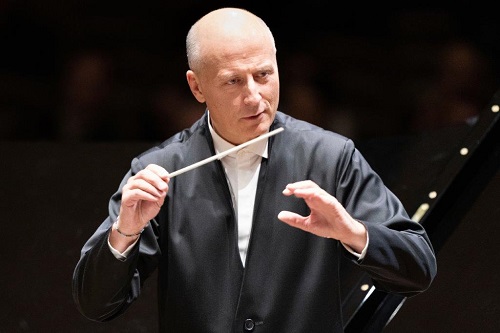 Switzerland Dukas, Stravinsky, Richard Strauss: Tonhalle Orchestra Zurich / Paavo Järvi (conductor), Tonhalle Maag, Zurich, 25.6.2020. (JR)
Switzerland Dukas, Stravinsky, Richard Strauss: Tonhalle Orchestra Zurich / Paavo Järvi (conductor), Tonhalle Maag, Zurich, 25.6.2020. (JR)

Dukas – Fanfare to La Péri
Stravinsky – Concerto ‘Dumbarton Oaks’
R. Strauss – Le bourgeois gentilhomme (orchestral suite) Op.60
Cultural life here in Zurich is making a tentative start towards whatever may become our ‘new normal’ in the concert hall. Until the end of June, the Swiss authorities are only permitting gatherings – still with social distancing of 2 metres and hand sanitisers – of no more than 300 persons. Consequently, the Tonhalle has devised a series of short concerts, with reduced numbers both in the audience and on stage. No drinks in the foyer before or after the concert, no interval, no handshake between conductor and Leader – the experience is purely musical and none the worse for that. It may be a while before we can immerse ourselves in a live Gurrelieder or Bruckner symphony again, but meanwhile we can enlarge our knowledge of chamber works. Cleverly, the Tonhalle has devised a series of concerts with such smaller-scale works, putting on performances at lunchtime, early evening and late evening. Happily, even though I suspect many in the audience probably fall into the category of ‘persons at risk’, there is such a yearning to hear live music again and tickets are selling reasonably well. We were handed washable facemasks (with Tonhalle Orchester logo) before the concert began, though only roughly half the audience bothered to wear them. Most of us had acres of space around us.
With Paul Dukas, everyone first thinks of Mickey Mouse, but there was more to this French composer than that. Dukas was a regular music critic before he started composing, eventually becoming Professor of Composition at the Paris Conservatoire. He studied with and befriended Debussy, and his pupils included Duruflé, Messaien, Ponce and Rodrigo. He was a perfectionist and destroyed many of his compositions, so we are left with only a few pieces. His last major work was the sumptuous oriental ballet La Péri. Because of the quiet opening pages of the ballet score, the composer added a brief thrilling brass ‘Fanfare pour précéder La Peri‘. Only three minutes long, but oh how the players relished the piece after weeks of lockdown. The audience too lapped it up. The very first notes made me realise how much I had missed real, live sound – listening to BBC Radio 3 or a CD, or streaming through the computer, just is not the same.
The chamber work Dumbarton Oaks derives its name from the estate of Robert and Mildred Bliss in Washington DC, who commissioned it (through the good offices of Nadia Boulanger) for their thirtieth wedding anniversary. Composed in Stravinsky’s neoclassical period (Pulcinella being his better-known and more melodic piece in this period), the twelve-minute long work is one of the composer’s two chamber concertos (the other being the Concerto in D for strings). The three movements, Tempo giusto, Allegretto, and Con moto, are performed without a break. The first uplifting movement of the concerto was heavily inspired by Bach’s Third Brandenburg Concerto, and was the last work Stravinsky completed in Europe (in 1937). In the witty, jaunty second movement the solo flute of Sabine Poyé Morel stood out. In the final movement, in more audible Stravinskian style, we heard war approach, Järvi accenting the rhythms in the strings to good effect. The orchestra was made up of ten strings, and a total of fifteen on stage.
For Richard Strauss’s neo-classical orchestral suite, composed in 1917, Le bourgeois gentilhomme, the orchestra was enlarged and for a moment it almost looked as though the stage was full. Strings were augmented, there was a panoply of percussion and even the grand piano took up some space.
Following the success of Der Rosenkavalier, Strauss and his librettist von Hofmannsthal came up with the idea of preparing a piece for theatre based on Molière’s Le bourgeois gentilhomme. It turned into a four-hour flop but Strauss created an orchestral suite; other parts went into Ariadne auf Naxos.
The work is in short sections. It starts with an Overture, which was actually the overture to the original Ariadne production in 1912. It is a modern pastiche of baroque musical gestures, full of delight and charm. The Minuet was a courtly dance; I almost thought we were listening to Johann Strauss. The Fencing-Master was full of flamboyant energy and wit, the pompous trombone having a lot of fun. The Entrance and Dance of the Tailors brought us a charming gavotte and an elegant polonaise. Concertmaster Julia Becker impressed with her solo. The Minuet of Lully is actually a piece that Lully wrote for the original production of Molière’s play in 1670, adapted by Strauss. Lush and beautiful, it offered the chance for solo flute, cello and violin to shine. The Entrance of Cléonte draws upon two passages from Lully, opening with Sarabande. It gave the chance for the woodwind to spring to life. Lastly, The Dinner, filled with musical jokes, brought us a quotation from Das Rheingold for the fish course and the main course must have been lamb (we hear the sheep from Don Quixote). A beautiful melody for cello follows, expertly executed by Principal Thomas Grossenbacher. Woodwind chirp merrily as songbirds abound. Finally, a lively waltz, with full percussion, Strauss’s music filled with joy.
The concert was perfect programming for this difficult time. The Tonhalle Orchestra had fetched their new musical director Paavo Järvi as soon as the Swiss border was re-opened in mid-June. The concert brought a smile to the faces of the players and the audience; it was a concert to lift the spirits. And wonder upon wonders – and with great relief – there was not a cough to be heard!
John Rhodes